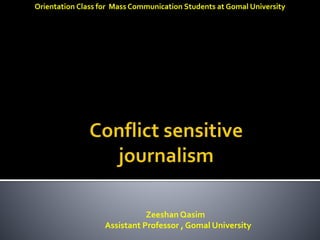
Mass Communication Students Orientation Class on Conflict Reporting
- 1. Orientation Class for Mass Communication Students at Gomal University Zeeshan Qasim Assistant Professor , Gomal University
- 2. An open clash between two opposing groups or individuals Opposition between two simultaneous but incompatible feelings Battle: a hostile meeting of opposing military forces in the course of a war A state of opposition between persons or ideas or interests Go against, as of rules and laws Dispute: a disagreement or argument about something important Conflict is a state of discord caused by the actual or perceived opposition of needs; values and interests. A conflict can be internal (within oneself) or external (between two or more individuals) Is a state of opposition, disagreement or incompatibility between two or more people or groups of people, which is sometimes characterized by physical violence
- 3. it is conventional that conflict will arise where: Un equal distribution of resources like food, housing, jobs or land. Conflicts related to the Rights and Justice, Power Inequities; Civil and Political Rights, Human Rights lack of communication between the actors misperception about each other like Inter-Groups’ Conflicts of Ethnicity, Race, Gender. Pent up emotions against each other Religious Sectarian and Moral values Political Issues Programs and Manifestoes. Common Cause among all types of conflicts is that they always breed on differences and competing goals, taking various forms and extremes.
- 4. Not all conflict is violent. Conflict is normal when there is change. Some people want change, but others disagree. If their disagreement or their conflict is managed peacefully, it can be a positive process. But when conflict is not managed properly, it becomes violent. In violent conflict, people fear for their safety and survival. When we say conflict, we are usually referring to violent conflict. Many times, violence is a result of conflict. Violence consists of actions, words, attitudes, structures or system that cause physical, psychological, social or environmental damage and/or prevent people from reaching their full potential.
- 5. Cultural violence arises out of a perception of one social group about the other. It takes many forms, such as: • Hate speech • Xenophobia • Myths and legends of war heroes • Religious justifications • Gender discrimination
- 7. Structural violence is harm, which is built into the laws and traditional behavior of a group or society. It can include: • Institutionalized racism or sexism • Colonialism • Extreme exploitation • Poverty • Corruption and nepotism • Structural segregation
- 8. To provide reliable information to the public in a time of violent conflict requires additional journalism skills. Reporters need to understand more about what causes conflict, and how conflict develops and ends. Reporters need to know where to look for these causes and solutions. By providing this information, journalism makes the public far more well-informed about the conflict beneath the violence, and can assist in resolving it. Reporters need to be aware of this crucial role that journalism can play in a time of conflict.
- 9. A conflict-sensitive approach involves gaining a sound understanding of the two-way interaction between activities and context and acting to minimize negative impacts and maximize positive impacts of intervention on conflict, within an organization's given priorities/objectives.
- 10. Understand the context in which you operate Understand the interaction between your intervention and the context Use this understanding to avoid negative impacts and maximize positive impacts of your intervention on conflict dynamics
- 11. No journalist can be completely objective. Journalists, like everyone, carry the values of their home country, their religion and their ethnic group. That is why professional journalists have standards for accuracy, impartiality and responsibility, to remove our personal values and bias.
- 12. Journalists are neutral but they ‘need to take sides’ for human rights, democracy and well being of the society!(see peace journalism) Because journalists can provoke or prevent violence arising from conflict! Because journalists can support the peace building process!
- 13. Avoid reporting a conflict as consisting of two opposing sides. Find other affected interests and include their stories, opinions and goals. Interview merchants affected by the general strike, workers who are unable to work, refugees from the countryside who want an end to violence etc. Avoid defining the conflict by always quoting the leaders who make familiar demands. Go beyond the elites. Report the words of ordinary people who may voice the opinions shared by many.
- 14. Avoid only reporting what divides the sides in conflict. Ask the opposing sides questions which may reveal common ground. Report on interests or goals which they may share. Avoid always focusing on the suffering and fear of only one side. Treat all sides’ suffering as equally newsworthy. Avoid words like devastated, tragedy and terrorized to describe what has been done to one group. These kinds of words put the reporter on one side. Do not use them yourself. Only quote someone else who uses these words.
- 15. Avoid emotional and imprecise words. Assassination is the murder of a head of state and no-one else. Massacre is the deliberate killing of innocent, unarmed civilians. Soldiers and policemen are not massacred. Genocide means killing an entire people. Do not minimize suffering, but use strong language carefully. Avoid words like terrorist, extremist or fanatic. These words take sides, make the other side seem impossible to negotiate with. Call people what they call themselves.
- 16. Avoid making an opinion into a fact. If someone claims something, state their name, so it is their opinion and not your fact. Avoid waiting for leaders on one side to offer solutions. Explore peace ideas wherever they come from. Put these ideas to the leaders and report their response. As journalists, our most powerful tools are the words we use. And the pictures and sounds. We can use our tools to build understanding instead of fears and myths.
